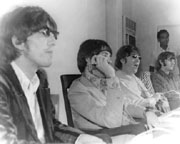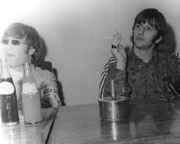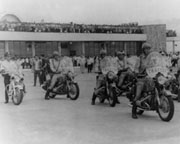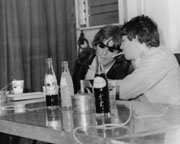 About forty years ago, The Beatles landed in the Philippines from
Tokyo for a two-concert stop. But what was anticipated to be The
Beatles' second biggest concert ever became a dark spot in the group's
history. Just exactly what happened on those fateful days remain
confusing to many. Was it simply a case of miscommunication, lack of
communication, false assumptions, opportunism? Whatever, the
Philippine experience became one of the last nails on The Beatles'
touring coffin as Neil Aspinall, a very close Beatle associate, put
it.
About forty years ago, The Beatles landed in the Philippines from
Tokyo for a two-concert stop. But what was anticipated to be The
Beatles' second biggest concert ever became a dark spot in the group's
history. Just exactly what happened on those fateful days remain
confusing to many. Was it simply a case of miscommunication, lack of
communication, false assumptions, opportunism? Whatever, the
Philippine experience became one of the last nails on The Beatles'
touring coffin as Neil Aspinall, a very close Beatle associate, put
it.
The Manila concert was the last leg in the fab four's two-week tour
of Germany and Japan. On July 3, 1966, The Beatles landed on
Philippine soil for the first and last time. This two-night stopover
in Manila proved disastrous from arrival to departure. Upon landing,
The Beatles were immediately whisked to a pier and put on Marina, a
yacht owned by Don Manolo Elizalde, two miles from the port. This
arrangement completely cut The Beatles from their associates for at
least two hours— the first time it ever happened.
 On July 4, The Beatles held two soldout concerts at the Rizal Memorial
Football Stadium with a combined attendance of 80,000; the evening
concert registered 50,000 paying audience, being rivaled only in size
by the concert The Beatles gave at Shea Stadium in New York on August
15, 1965. Such record-making statistic though was supplanted by the
succeeding events owing to a fiasco that happened earlier in the day.
On July 4, The Beatles held two soldout concerts at the Rizal Memorial
Football Stadium with a combined attendance of 80,000; the evening
concert registered 50,000 paying audience, being rivaled only in size
by the concert The Beatles gave at Shea Stadium in New York on August
15, 1965. Such record-making statistic though was supplanted by the
succeeding events owing to a fiasco that happened earlier in the day.
The Beatles' alleged snub of then-First Lady Imelda Marcos remains
hazy to many Beatles fans. Even reliable sources maintain conflicting
accounts.
The common story goes this way.
On July 4, a lunch was set at Malacañang Palace at 11 a.m. with 300
children waiting to see The Beatles. An hour before the party, a
delegation came to the Manila Hotel to collect The Beatles. Brian
Epstein, The Beatles' manager, declined the invitation on the grounds
that no earlier arrangement had been made and The Beatles were still
in bed.
The day's scheduled concerts, however, later proceeded
successfully. In between concerts, local televisions reported the
alleged "snub" showing footages of children, some crying, disappointed
by The Beatles. Epstein watched in horror and went immediately to the
television studio to apologize and set the facts straight. But barely
had he started reading his press statement when the transmission
blipped.
Newspapers carried the headline, "Beatles Snub President." The
following morning was the scheduled departure of The Beatles to New
Delhi. Suddenly, The Beatles and their entourage realized they were
practically on their own without any help: Room and transportation
services were withdrawn. In the airport, the whole Beatles entourage
was manhandled as it made its way to the plane.
Tony Barrow, the tour's publicity man and part of the entourage,
claimed that Epstein received the invitation the night before the
concerts but remained noncommittal. Whether it was wise for the local
promoter to take this silence as approval is now moot.
 Bill Harry, in his book The Ultimate Beatles Encyclopedia,
acknowledges the existence of an invitation from Ramon Ramos, the
local promoter, for The Beatles to pay a courtesy call on the First
Lady, but it was slated for 3 p.m. of July 4, an hour before The
Beatles' scheduled afternoon concert. Ramos did not pursue this
invitation, since The Beatles wanted to be in the concert location two
hours before the set. Nor did he inform anyone in Malacañang about
this. A further mixup in schedule emerged when the Palace set the
meeting at 11 a.m. as reported in The Manila Times on July 3. Whether
anyone went out of his way to settle the matter, and what transpired
in this effort, if any, remains unknown.
Bill Harry, in his book The Ultimate Beatles Encyclopedia,
acknowledges the existence of an invitation from Ramon Ramos, the
local promoter, for The Beatles to pay a courtesy call on the First
Lady, but it was slated for 3 p.m. of July 4, an hour before The
Beatles' scheduled afternoon concert. Ramos did not pursue this
invitation, since The Beatles wanted to be in the concert location two
hours before the set. Nor did he inform anyone in Malacañang about
this. A further mixup in schedule emerged when the Palace set the
meeting at 11 a.m. as reported in The Manila Times on July 3. Whether
anyone went out of his way to settle the matter, and what transpired
in this effort, if any, remains unknown.
Peter Brown, the executive director of NEMS Enterprises (The
Beatles' Vic Lewis, the tour agent, received the invitation while
still in Tokyo but failed to relay this to him.
What is interesting about Brown’s account though was the call
Epstein received, immediately after his refusal, from the British
ambassador, who advised him against missing the party of the First
Lady, and reminded him that the help and protection they were
receiving in Manila was courtesy of the President. Epstein stood by
his decision. Whether The Beatles would have come to the party even if
Epstein recalled his decision is another question though.
UNKNOWN to many, almost 40 years ago on July 4, 1966, The Beatles
made history in Manila. They played twice to the biggest paying crowd
in a single day in Manila with at least a combined audience of 80,000
in attendance, unmatched anywhere in the band’s touring history.
At 4:00 p.m. that day, The Beatles launched their first gig before
a delighted crowd of 30,000 at the Rizal Memorial Football Stadium,
yet unaware of the ugly events that awaited them owing to their
inadvertent failure to show up at a luncheon party for them in
Malacañang.
Four hours later, The Beatles returned to the same place for their
second and last concert in Manila, this time to a crowd of 50,000. The
latter, grossly ignored by many to this day, is The Beatles’
second-biggest concert attendance in history, surpassed only by their
concert at the Shea Stadium in New York in August of 1965.
All in all, the Beatles performed 11 songs in their Manila
con-certs. They opened with the Chuck Berry original Rock and Roll
Music and followed it up with 10 original Beatles compositions: “She’s
a Woman,” “If I Needed Someone,” “Day Tripper,” “Baby’s in Black,” “I
Feel Fine,” “Yesterday,” “I Wanna be Your Man,” “Nowhere Man,”
“Paperback Writer” and “I’m Down.”
This repertoire of less than a dozen songs basically went unchanged
throughout the Beatles’ tour of Germany, Japan and Manila. In fact,
the Beatles performed the same standard set when they toured the
United States for the last time in August 1966, a month after the
“Manila nightmare.”
From time to time, The Beatles deviated from this set by taking on
“Long Tally Sally” instead of “I’m Down” as closing climax. On few
occasions, they played both. Encore performances were probably not yet
in vogue then, because whenever Paul introduced the last song with the
line “Our next number will be our last number . . . ”, it was indeed
the end of the show. Straight from the platform, The Beatles, as a
rule, proceeded immediately to a waiting car parked nearby for a swift
exit from the concert arena.
A recording of The Beatles’ concert here in Manila has yet to
surface, if any. We listened to their last ever concert to a paying
audience in Candlestick Park in San Francisco on August 29, 1966, and
it carried the same standard repertoire. The whole concert clocked
around 30 minutes, including the adlibs. By today’s standards, this is
way too short. For example, Paul McCartney’s 3,000th gig in St.
Petersburg on June 20, 2004, reportedly lasted for two and a half
hours despite the threat of a downpour.
 If anything, the concert in Manila proved that The Beatles were at the
height of their success. One member of the audience present in this
historical concert, a nine-year-old boy at the time, posted a comment
in a website devoted to The Beatles back in 1999. He remembers that he
was one of the spectators along with his two other older brothers. He
said The Beatles looked too small as he and his brothers were seated
in a more distant section from the stage and their singing could
hardly be heard as their vocals were drowned by the screaming of fans.
If anything, the concert in Manila proved that The Beatles were at the
height of their success. One member of the audience present in this
historical concert, a nine-year-old boy at the time, posted a comment
in a website devoted to The Beatles back in 1999. He remembers that he
was one of the spectators along with his two other older brothers. He
said The Beatles looked too small as he and his brothers were seated
in a more distant section from the stage and their singing could
hardly be heard as their vocals were drowned by the screaming of fans.
Some of our best artists fronted for The Beatles in these concerts.
They included Eddie Reyes and D’Downbeats (with the D’Cavalcade
Dancers), Dale Adriatico, Wing Duo, Pilita Corrales, Lemons Three,
Quartet (accompanied by Pilita Corrales and The Lemmons Three) and The
Reycard Duet.
Based on the photos available on the Internet, the cost of a
grandstand ringside ticket then was P30, while a field reserved ticket
had a tag price of P20. Gate receipts from the two concerts totaled
$100,000.
Despite the bitter experience that The Beatles and their entourage
experienced at the hands of airport security personnel when they left
the country, they did not leave without posting yet another milestone
in their touring history with their Manila concerts.
By Lambert Ramirez